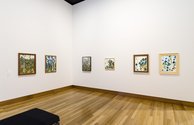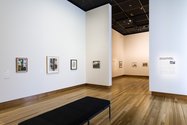John Hurrell – 4 November, 2016
These rhythmical (at times prismatic) works, painted on the wooden sundeck he built onto their French Bay home, are particularly rewarding for the inquisitive viewer, especially for those familiar with the Titirangi district (its dense native bush, flickering light and sheltered beaches) keen to see how, using a vague grid, McCahon structured his inspirational landscape material, his vegetative catalyst.
Christchurch
Colin McCahon
From the Sun Deck: McCahon’s Titirangi
Curated by Peter Vangioni
17 September 2016 - 6 February 2017
A dozen works (nine oil paintings on board, one ink drawing on paper, and two lithographs) make up this small survey that looks at the Titirangi / French Bay landscapes made in the early - to - late fifties. McCahon had come up from Christchurch in June 1953, to work at Auckland Art Gallery, and intellectually he was going through big changes - abandoning the biblical narratives of the South Island that he was then famous for. It was a time of change, diverse exploration and great productivity.
In this very focussed show that covers a six year period, most of the carefully selected paintings from outside Christchurch Art Gallery itself have been borrowed from other South Island institutions such as the Dunedin Public Art Gallery, the Forrester Gallery and the Hocken Library, while another has been partially gifted to the Christchurch Art Gallery by the Jean Norrie estate. They were chosen by Peter Vangioni, one of the gallery’s New Zealand art curators, the works on paper specialist.
Although in this time frame, McCahon was exploring several other painting types as well (such as exploring the letter shapes of words and numbers; writing cursive texts; thinking about unusual supports like canvas ‘scrolls’; or paints, like Dulux enamel) plus experiencing a revelatory four month trip to North America, these cubist/constructivist investigations - derived from the clumps of Kauri and Pohutukawa that surrounded the small cottage the McCahon family lived in - show him boldly moving towards an angular abstraction.
These rhythmical (at times prismatic) works, painted on the wooden sundeck he built onto their French Bay home, are particularly rewarding for the inquisitive viewer, especially for those familiar with the Titirangi district (its dense native bush, flickering light and sheltered beaches) keen to see how, using a vague grid, McCahon structured his inspirational landscape material, his vegetative catalyst. And of interest for those also who happen to have a copy of Peter Simpson’s wonderfully informative book, Colin McCahon: The Titirangi years, 1953-1959 (AUP, 2007), a publication rich in illustrations and detailed biographical history.
Vangioni’s selection is particularly useful in that it allows us to compare the two types of tree represented within two types of composition, two types of light and two types of space: Kauri (1955-56) versus Pohutukawa (1957-8). The earlier Kauri works are reminiscent of Braque’s and Picasso’s early form of cubism, having conspicuous circular and diagonal elements (shafts of sunlight) that gradually get outnumbered by vertical (trunk) components. In the Pohutukawa works, the paintings and their brush strokes become smaller and the light more airy - with darker lozenges and oblongs taking over so that the verticals and circles get replaced by diagonal (tidal) planes. (These soon will be extrapolated into the more confrontational Gate series.)
The result is a different type of intensity where the intermingling light becomes whiter and sandier: less smoky and more piercing: less about leaf-dense dappled air and more about the glary beach. Walking through clusters of towering trees becomes transmuted to that of aerial perspective - so that looking across changes to looking down.
There are other similar suites of painting Vangioni could have picked, like the darker French Bay works for example, with their myriad rectangles, or more of the curvilinear Towards Auckland series, of which he did include one. The emphasis here though is on the artist’s sparked off response to tree forms and daylight as an incentive for the further exploration of abstraction - perhaps ending up today with a wider appeal and fascination, a fuller appreciation.
John Hurrell









 Advertising in this column
Advertising in this column Two Rooms presents a program of residencies and projects
Two Rooms presents a program of residencies and projects



This Discussion has 0 comments.
Comment
Participate
Register to Participate.
Sign in
Sign in to an existing account.